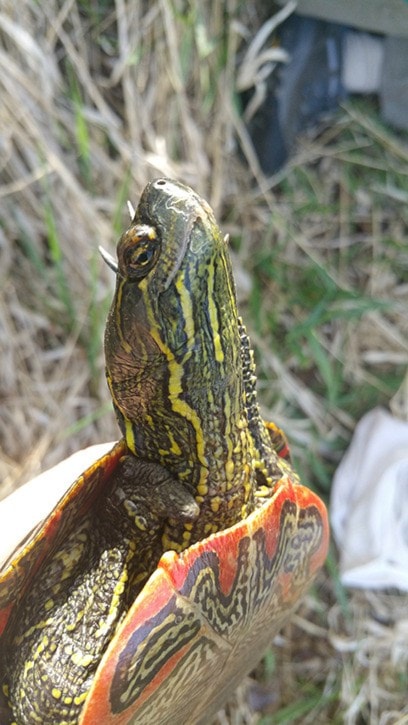Have you seen turtles on or near the road recently? If so, it is because turtle nesting season has begun, and female turtles are looking for areas to make a nest and lay their eggs. Females prefer to dig in places that have loose soil, since they can’t dig effectively in thick vegetation — road shoulders are ideal locations. For a variety of reasons, however, roadsides are not the safest place for females or turtle hatchlings.
As you might have guessed, traffic poses a large threat to adult females who are laying eggs, as well as to hatchlings once they emerge from the nest. Road mortality results in females being killed at a higher rate compared to males. Removing females from a population can have a long-lasting effect, particularly because turtles are long-lived (40-50 years old). It is important to watch for turtles on the road while driving near any water body such as wetlands, ponds or lakes.
In addition to road mortality, nests on the side of the road experience a higher rate of predation than nests in safer locations. Predators such as skunks, raccoons and coyotes learn that they can simply walk along the shoulder of the road and dig up any nests that they find; they do not need to actively search for the nests or deal with any obstacles. As a result, these nest predators are much more efficient at locating and destroying the turtle nests.
The roadside is also home to many invasive plants, such as knapweed, where they become established and grow quickly. Knapweed is abundant throughout the Creston Valley, especially near to the roads where the soil has been disturbed. These invasive plants move into open gravel areas where turtles can nest, often forcing turtles to select gravel areas closer to the road. In addition, knapweed roots have been shown to grow into turtle nests, thereby ensnaring the hatchlings inside.
If you see a turtle on the road, and the likelihood of it being hit is low, the best thing to do is to let it cross on its own. If you think the turtle will be hit, safely pull over on the road shoulder and put on your hazard lights. Make sure other drivers see you before stepping onto a road. Always move the turtle in the direction that it was originally travelling; if it is moving away from the water to nest, and you move it back to the water, it will re-try crossing the road.
When picking up a turtle, grasp it on either side of its shell behind the front legs. The turtle will still be able to kick at you, but many will choose to stay safely tucked in during the short time you are moving them. Keep the turtle low to the ground when moving — even small turtles have surprising strength. If a turtle pushes free of your grip, you do not want it to fall and injure itself.
Informed and observant drivers are the best defense against road mortality. Western painted turtles will generally nest from mid-May to July, so remember to keep an eye out for our friends on the road during the next few weeks.
—VAST RESOURCE SOLUTIONS
